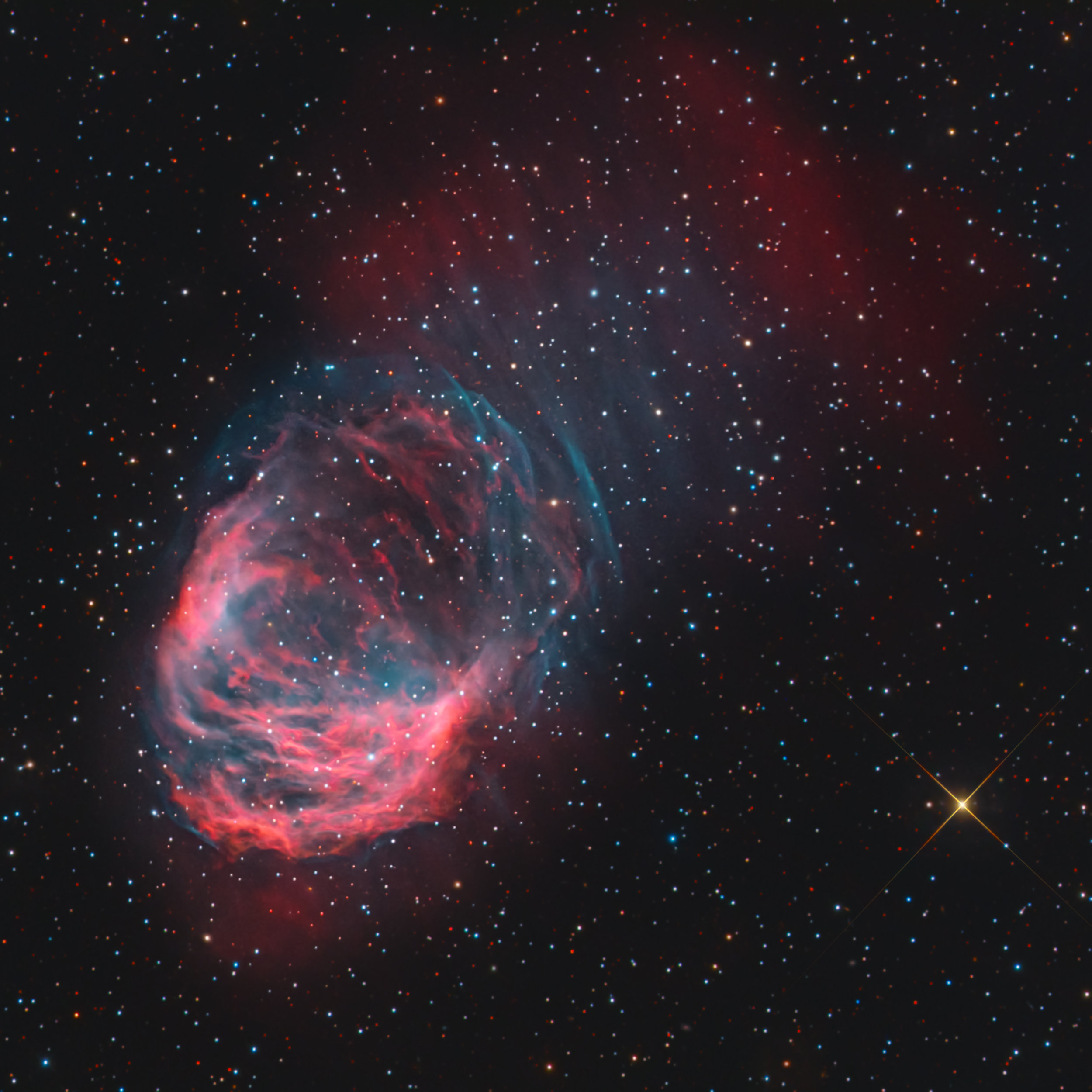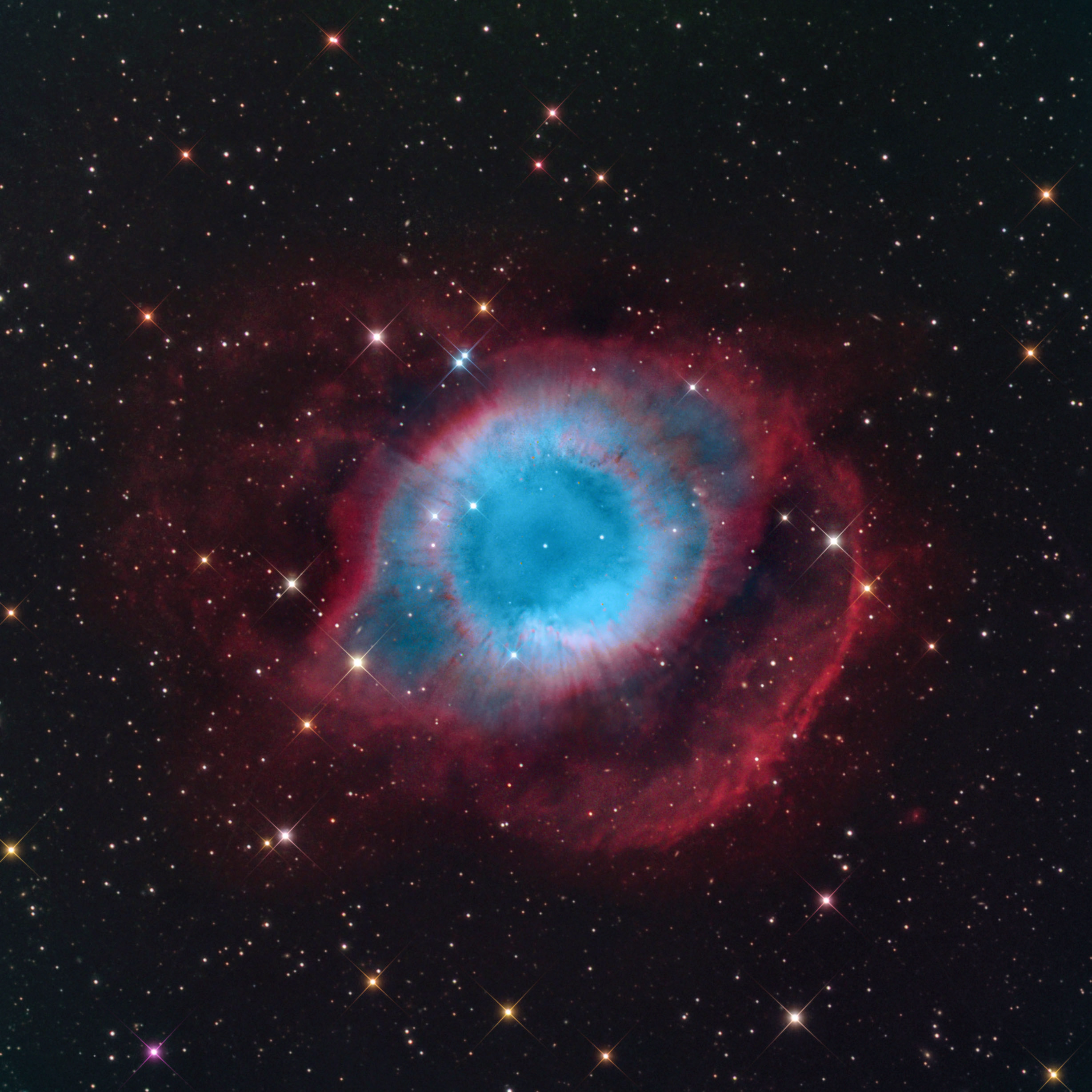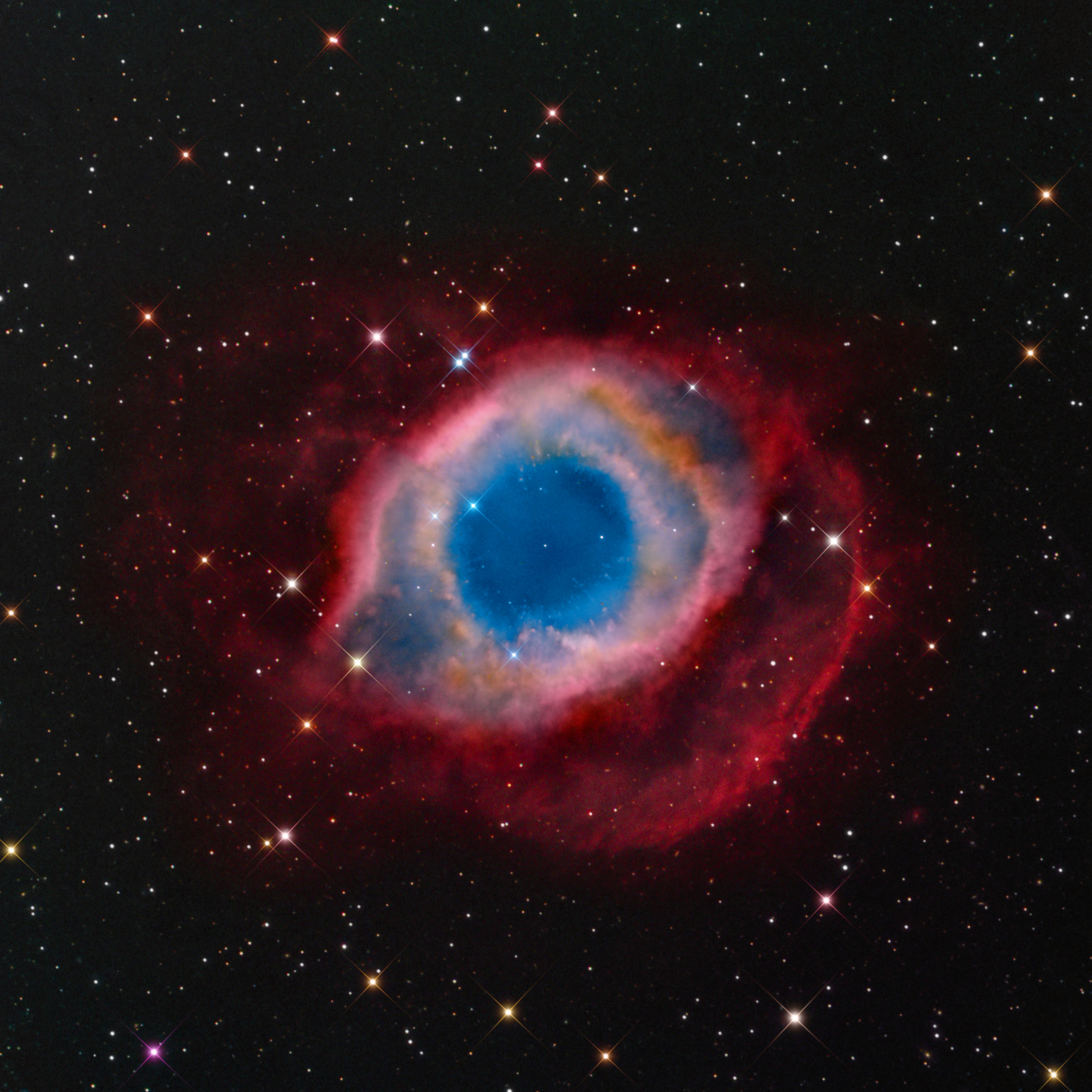
Helix Nebula NGC 7293
Star Death: Helix Nebula
Tracing the final stages of a star’s life by watching it expel material.
Thousands of comet-Like filaments likely formed when hot stellar winds and radiation plowed into colder shells of gas and dust.
Some stars die slowly, giving off puffs of gas and dust known as planetary nebulas to reveal small white dwarfs. Much larger stars die suddenly in powerful explosions known as supernovas, blasting gas, dust, and energy out in all directions as they collapse to form tiny neutron stars or black holes. The gas and dust expelled by dying stars eventually combines with the remains of others to form new stars, planets, and moons.
As the dying star at the center of the Helix Nebula exhausted its fuel, it threw off its outer layers as a gaseous wind and transformed into a white dwarf. As the glowing shells of gas expand over 10,000 years, they eventually thin out and become part of the interstellar medium. Planetary nebulas provide a snapshot of a transitional phase in the life and death of a star.
Quick Facts: Helix Nebula
Also known as: NGC 7293
Type of object: Planetary nebula
Distance from Earth: 700 light-years
Location in the sky: Aquarius Constellation
Did you know: The Helix Nebula is more like a cylinder than a bubble—one end is pointing directly at Earth.

NGC 2867 or Caldwell 90
NGC 2867- “A Rare Look”
A rare view of this Planetary nebula shows the earie shroud of HA and O3 surrounding the core of this PN.
NGC 2867 (also known as Caldwell 90) is an elliptical Type II planetary nebula in the southern constellation of Carina, just over a degree to the NNW of the star Iota Carinae. John Herschel discovered the discovery on April 1, 1834.
Herschel initially thought he might have found a new planet, but on the following night he checked again and discovered it had not moved. The nebula is located 7,270 light-years from the Sun.
Caldwell 90 was formed in the late stages of the development of a Sun-like star. Following the nuclear fusion of hydrogen into helium in its core, the star underwent a series of energy crises when its supply of hydrogen began to decline. Without the outward force previously created by the energy production, gravity shifted and caused the star's core to contract.
The extra pressure allowed the star to produce a heavier substance in its core. The synthesis of carbon produced a lot more energy than the fusion of hydrogen into helium, which enabled the star to not only overcome gravity to expand once more but led the star to become a red giant.
Eventually the red giant’s outer layers of gas were ejected. Meanwhile, the star transformed from a cool giant into a hot, dense star that radiates ultraviolet light and a fast wind of particles that move outward at around 6 million miles per hour. The stellar wind and ultraviolet light interact with the layers of gas that the red giant ejected to create the glowing, spherical shell we see today.
Image Processing: Mark Hanson
Data: Martin Pugh
Enjoy, Mark

HFG-2 Planetary Nebula
HFG2
HFG-2 is cataloged as a planetary nebula in the Simbad catalog and appears to be PK247-04.1 in the galactic planetary nebula catalog. It was discovered by Heckathorn, Fesen and Gull in 1983. It is in the southern constellation of Puppis about 6,000 light years distant.
This planetary nebula is oval with a unique shape, to me it looks like a sponge from the ocean.
Notice the faint but very apparent extended OIII halo structure forming around the spheroid of this very interesting object.
The Ha emissions look like they are interacting with HFG-2, but have found no information that supports this anywhere, not sure if they or not.
Image Processing: Mark Hanson
Data: Martin Pugh
Enjoy, Mark Hanson

NGC 3132 The Southern Ring Nebula
NGC 3132 (also known as the Eight-Burst Nebula because of its figure-8 appearance through small telescopes, or the Southern Ring Nebula) is a very bright, asymmetric planetary nebula of approximately 0.4 light-year across, located about 2,000 light-years away in the southern constellation Vela. It is moving away from us at 49 kilometers per second.
Despite their name, planetary nebulae have nothing to do with planets. The name of planetary nebulae arose because of the visual similarity between some round planetary nebulae and the planets Uranus and Neptune when viewed through early telescopes.
When a star with a mass up to eight times that of the Sun approaches the end of its life, it blows off its outer shells and begins to lose mass. This allows the hot, inner core of the star to radiate strongly, causing this outward-moving cocoon of gas to glow brightly as a planetary nebula.
Over the next several thousand years, the nebula will gradually disperse into space, and then the star will cool and fade away for billions of years as a white dwarf. Our own Sun is expected to undergo a similar fate, but fortunately this will not occur until some 5 billion years from now.
There are two stars close together — a binary system — in the center of NGC 3132, one of 10th magnitude, the other 16th. It’s the dim star, not the bright one, near the center that caused multiple outbursts and originated the intricate, somewhat concentric structure of the nebula. This hot central star is a white dwarf of about 100,000 K that has now blown off its layers and is making the nebula fluoresce brightly from the emission of its intense ultraviolet radiation.
This expanding cloud of gas is one of the nearest known planetary nebulae. The gases are expanding away from the central star at a speed of about 14.4 kilometers per second. Neither the unusual shape of the surrounding cooler shell nor the structure and placements of the cool filamentary dust lanes running across NGC 3132 are well understood.

M46 & Planetary Nebula NGC 2438
M46 & Planetary Nebula NGC 2438
Messier 46 or M46, also known as NGC 2437, is an open cluster of stars in the slightly southern constellation of Puppis. It was discovered by Charles Messier in 1771. Dreyer described it as "very bright, very rich, very large." It is about 5,000 light-years away. There are an estimated 500 stars in the Cluster.
NGC 2438 is a planetary nebula (Left Center) The central star is roughly 1,370 light years. So closer than M46 cluster. This is a multi-shell planetary nebula with a bright inner nebula consisting of two somewhat detached shells. The structure is surrounded by a fainter, mostly circular halo.
The nebula consists of material ejected from the central star. The main nebula was formed at about half that age. The central star of this planetary nebula is one of the hottest stars known.
Image Processing and Calibration: Mark Hanson
Data Collection: Hanson, Mazlin, Parker, Forman 2021
Telescope1: 24" Planewave CDK f6.5 and L600 Mount, Camera SBIG 16803 Location: SWOS, El Sauce Chile
Enjoy, Mark

NGC 2932
NGC 2932
The Eskimo Nebula (NGC 2392), also known as the Clown-faced Nebula, Lion Nebula, or Caldwell 39, is a bipolar double-shell planetary nebula (PN). It was discovered by astronomer William Herschel in 1787. The formation resembles a person's head surrounded by a parka hood. It is surrounded by gas that composed the outer layers of a Sun-like star. The visible inner filaments are ejected by a strong wind of particles from the central star. The outer disk contains unusual, light-year-long filaments.
This is quite something considering the elevation of 25 degrees and size of 43” Great work getting this Steve Mazlin and Stuart Forman.
Imaged from SWOS in El Sauce, Chile in April 2023 using a 24″ Planewave CDK @ f/6.5 and SBIG STX-16803. Image scale 0.47″/pixel with 2.5 hours Ha, 2.5 hours OIII, and 2.5 hours S2. Processing in PixInsight and PS.
Image Processing: Mark Hanson
Data: Mazlin, Forman, Hanson, Parker
You can see Steves version here: https://ourcolorfulcosmos.com/mazlin/nebulae/ngc-2392/
Enjoy, Mark

Henize 2-111 (PN G315.0-00.3) planetary nebula in Centaurus
Henize 2-111 (PN G315.0-00.3) planetary nebula in Centaurus in HOS colors by Zaytsev and Hanson
Remarkable planetary nebula Henize 2-111 (also being referred to as He 2-111, Hen 2-111, and cataloged as PN G315.0-00.3) [1-4] in Centaurus constellation. Type I (helium and nitrogen rich) planetary nebula by Peimbert classification [5], He 2-111 has a planar bipolar asymmetrical shape, which is found to be likely shaped by a triple stellar system in [3, 4]. With estimated distance to the nebula of about 6.8 kly [1-2] and long axis angular length of about 10’ the diameter if the “lobes” corresponds to about 20 ly and the long axis of the core of the nebular of about 30” corresponds to about 1 ly. Thus, the nebula lies much further away than HD 127470 star (830 ly away) - the brightest star in the frame above the core of He 2-111, but roughly at the same distance as a nearby NGC 5617 open cluster (6.5 kly).
The central star (or rather central stars) of this nebula have never been observed, but its core reveals a complex structure featuring a toroid placed at about 45 deg inclination to the plane of the “lobes”, with the outer diameter along the major axis of 20” and inner diameter along the same axis of 14” or 0.7 ly and 0.5 ly of linear size correspondingly, based on the best available distance estimates from above. This toroidal structure in the core turned out to be best visible in the SII channel, and adding it to the exposure set allowed to boost visibility of fine details in the core compared to HO(L)RGB images of this object obtained earlier.
Two sets of “spokes” are reaching out from the core of the nebula to the periphery which consists of fast moving radially extended “knots” of material for which the radial velocity is found to be reaching 650 km/s which put the age of the nebula in the range of 8-20 ky depending on the model of the expansion [1, 2]. A peculiar cusp-like structure is visible next to one of the “spokes” on the left from the core, revealed in a fully connected way in this image, likely for the first time. Extended diffuse structures visible on the outer side of the lobes of the nebula (best visible in the starless version of the image) - also likely for the first time.
ASA Ritchey-Chretien RC-1000: D=1m, f/6.8 on alt-azimuthal direct drive fork mount, FLI ProLine 16803 with secondary mirror based motorized focusing and automatic de-rotation (Telescope #1 system of ChileScope observatory, Río Hurtado Valley, Chile).
Data and initial calibration/integration: Alexandr Zaytsev https://www.astrobin.com/users/m57ring/ 14x Ha + 9x OIII + 8x SII guided 600 sec exposures (5h10m of combined integral) collected over 3 imaging sessions carried out on Jun 11, 12, 13 of 2023 using Chilescope Telescope #1 system.
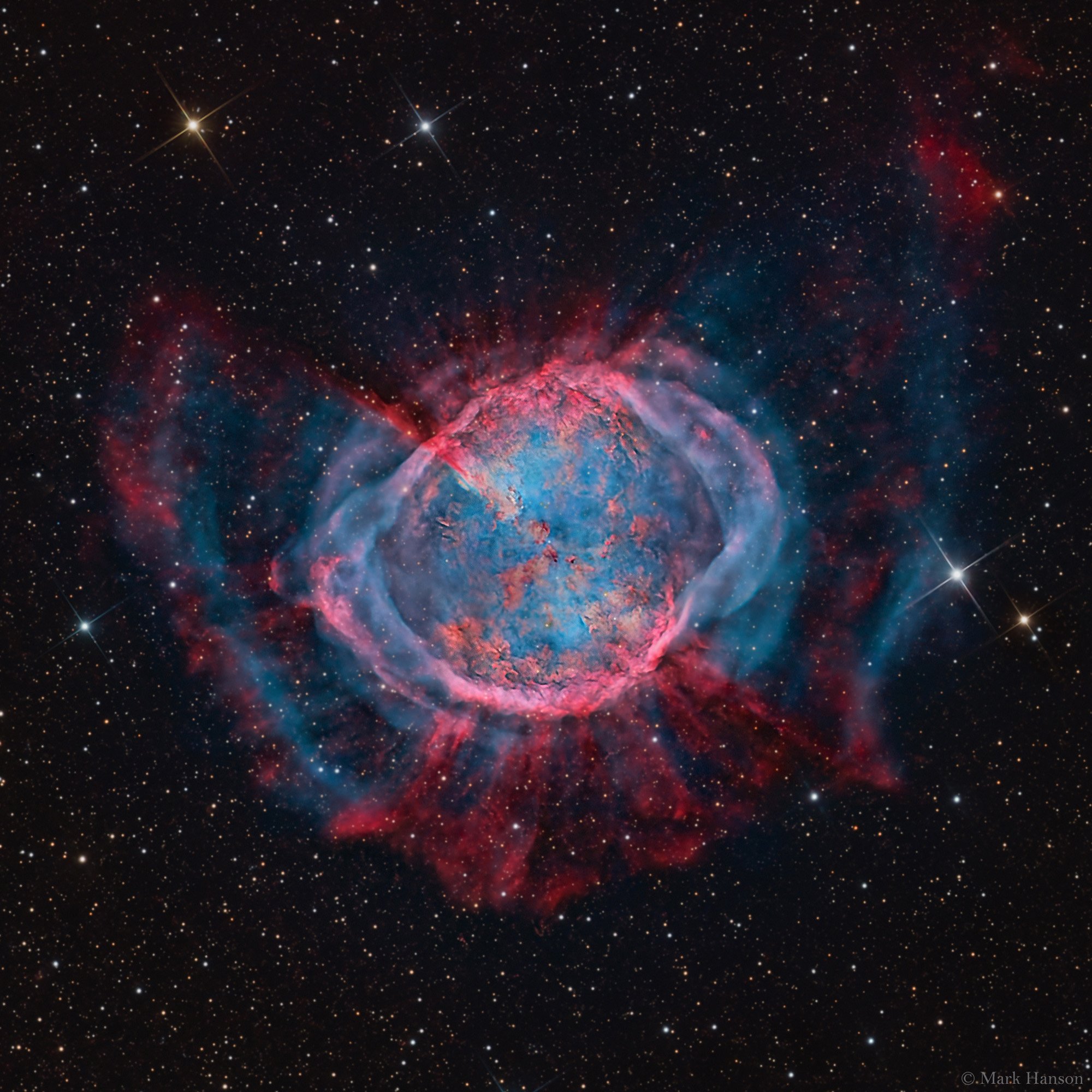
M27 The Dumbbell Neblua
M27 The Dumbbell Nebula (New Version)
The first hint of what will become of our Sun was discovered inadvertently in 1764. At that time, Charles Messier was compiling a list of diffuse objects not to be confused with comets. The 27th object on Messier's list, now known as M27 or the Dumbbell Nebula, is a planetary nebula, the type of nebula our Sun will produce when nuclear fusion stops in its core. M27 is one of the brightest planetary nebulae in the sky, and can be seen toward the constellation of the Fox (Vulpecula) with binoculars. It takes light about 1000 years to reach us from M27. Understanding the physics and significance of M27 was well beyond 18th century science. Even today, many things remain mysterious about bipolar planetary nebula like M27, including the physical mechanism that expels a low-mass star's gaseous outer-envelope, leaving an X-ray hot white dwarf.
Telescope: 14.5 RCOS, Paramount ME2, Camera: SBIG 16803, Recently added data from Planwave 24".
Location: DGRO, Animas, New Mexico
Exposure: O3 600, HA 360, S2 360, Luminance 240, Red 160, Green 160, Blue 160
Enjoy, Mark Hanson

IC 5148
IC 5148
IC 5148 is a planetary nebula located around 3000 light years away in Grus. The nebula features a halo of hot ionized material, and there are gas outflows beyond the halo that are evident in the image. In the field of view the nebula is only 2×2’, and is quite faint necessitating long exposure integration times.
Imaged in H alpha and Oxygen III with RGB for star color.
Taken on our 24” CDK at SWOS in Taken El Sauce, Chile
Image Processing Mazlin-Hanson

Abell 35
Abell 35
Abell 35 is classified as a Planetary Nebula albeit unusual by shape and brightness. However recent studies in 2010 by Frew and Parker conclude that it is actually a Stromgren sphere in the ambient interstellar medium ionized by a hot DAO white dwarf star.
Imaged in RGB with H alpha and Oxygen III, OTA CDK 24 at Observatorio El Sauce, Chile.
Image Processing: Mark Hanson and Mike Selby
Enjoy,
Mike & Mark

Abell 7
Explanation: Very faint planetary nebula Abell 7 is some 1,800 light-years distant, just south of Orion in planet Earth's skies in the constellation Lepus, The Hare. Surrounded by Milky Way stars and near the line-of-sight to distant background galaxies, its generally simple spherical shape, about 8 light-years in diameter, is outlined in this deep telescopic image. Within its confines are beautiful, more complex details enhanced using narrowband filters. Emission from hydrogen and nitrogen is shown in reddish hues with oxygen emission mapped to a bluish-green color, giving Abell 7 a more natural appearance that would otherwise be much too faint to be appreciated by eye. A planetary nebula represents a very brief final phase in stellar evolution that our own Sun will experience 5 billion years hence, as the nebula's central, once sun-like star shrugs off its outer layers. Abell 7 itself is estimated to be 20,000 years old. Its central star is seen here as a fading white dwarf some 10 billion years old.

NGC 1360 The Robin's Egg Nebula
This pretty cosmic cloud lies some 1,500 light-years away, it shape and color reminiscent of a blue robin's egg. It spans about 3 light-years, nested securely within the boundaries of the southern constellation Fornax. Recognized as a planetary nebula, NGC 1360 doesn't represent a beginning though. Instead, it corresponds to a brief and final phase in the evolution of an aging star. In fact, visible in the telescopic image the central star of NGC 1360 is known to be a binary star system likely consisting of two evolved white dwarf stars, less massive but much hotter than the Sun. Their intense and otherwise invisible ultraviolet radiation has stripped away electrons from the atoms in the surrounding gaseous shroud. The predominant blue-green hue of NGC 1360 seen here is the strong emission produced as electrons recombine with doubly ionized oxygen atoms.
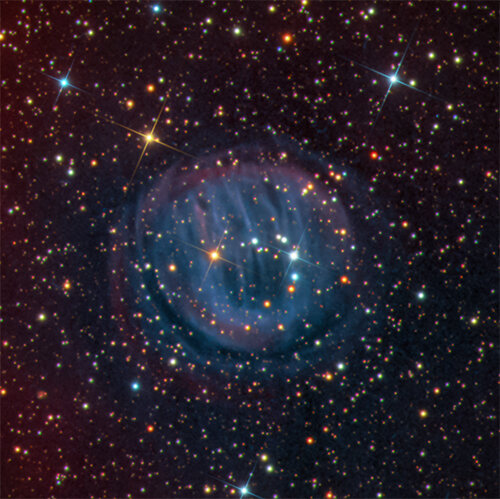
HDW 2 (Sh2-200)
HDW 2 (Sh2-200):
This exquisitely detailed image is a portrait of the planetary nebula HDW 2, which is located towards the royal constellation of Cassiopeia. Consisting of iridescent shades of purple and blue, this ethereal bubble represents the ghostly remains of a dying star. The category of planetary nebulae was given its name due to telescopic observations by 18th century astronomers such as William Herschel and others being described as similar in appearance and brightness to planets. In astronomy, many things are named after their resemblance to something.
HDW 2 is a very faint ancient planetary nebula of low surface brightness, therefore making telescopic observations very difficult. Faint planetary nebulae such as this one are best appreciated in detailed astrophotographs such as this one and even then, long exposures of many hours are still required. Whilst in the past planetary nebulae might have been discovered through direct visual observations, the many discoveries made in the 21st century have been through photographic means. Some discoveries have been made by professionals as part of large scale surveys such as the Ear Nebula and some discoveries have been due to amateur astrophotographers such as the Soap Bubble Nebula.
This nebula was first discovered by the astronomer Stewart Sharpless in 1959 who included it in his catalogue of HII regions under the name of Sh2-200. His catalogue was compiled after analysing photographic plates taken at the Palomar Observatory. The misidentification of HDW 2 (or Sh2-200) arose from the criteria of assembling the catalogue, which compared the separate red and blue photographic plates of the same region. If a nebula was more prominently visible on the red plate, it was deduced that it was more likely to be an ionized nebula. The other criteria was the presence of bright stars in the vicinity, which might be the source of ionization.
Despite increasing the number of catalogued and known deep sky objects, the method of analysing monochromatic photographic plates displayed its limitation with the incorrect classification of nebulae with a number of entries in the Sharpless catalogue of HII regions subsequently being found to belong to different categories of objects such as planetary nebulae, supernova remnants, Wolf Rayet nebulae, high latitude dust clouds and even galaxies.
In 1983, Sh2-200 was included in the HDW catalogue of possible planetary nebulae by the astronomers Herbert Hartl, Johann Dengel and Ronald Weinberger. However it wasn't confirmed to be a true genuine planetary nebula until 2017 when spectra was taken as part of professional observations. In 1987, further narrowband observations by Herbert Hartl and Ronald Weinberger detected a large faint outer halo extending further than the central shell.
A feature not fully appreciated or clearly defined in the scientific literature is something known as ISM-type haloes. These are a type of structure that represent ambient interstellar gas in the vicinity of the planetary nebula but not physically related to it. Despite being very old and highly evolved, low surface brightness planetary nebulae such as HDW 2 contain very hot and energetic central stars, which are the remnant cores of the progenitor star that died and ejected its outer gaseous layers. The energy output of some planetary nebula central stars is so prodigious that it is capable of ionizing unrelated gas in the surrounding vicinity causing it to glow. The most popular example of this phenomenon is the large halo around NGC 3242.
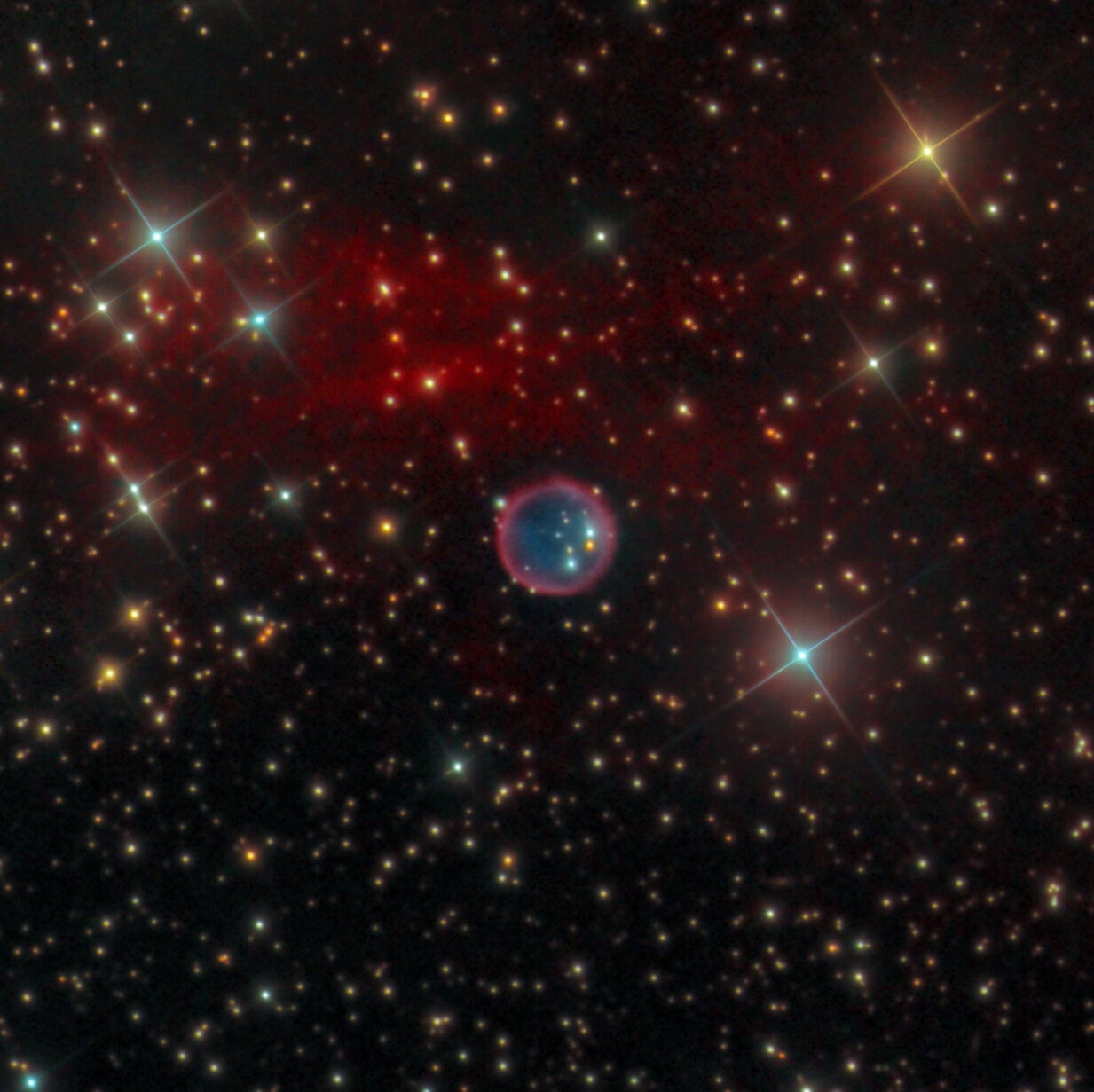
Abell 8
Abell 8 is a 1 arcminute planetary nebula consisting of a Ha bright rim and an OIII interior. Deep narrowband images such as this one show extended clouds of hydrogen in the vicinity. This isn't material ejected by the progenitor star but ambient material in the surrounding interstellar medium (ISM) that is being ionized by ultraviolet radiation of the central star leaking out of the thin gaseous shell of the planetary nebula. Abell 8 was discovered by the astronomer George Abell in 1955.
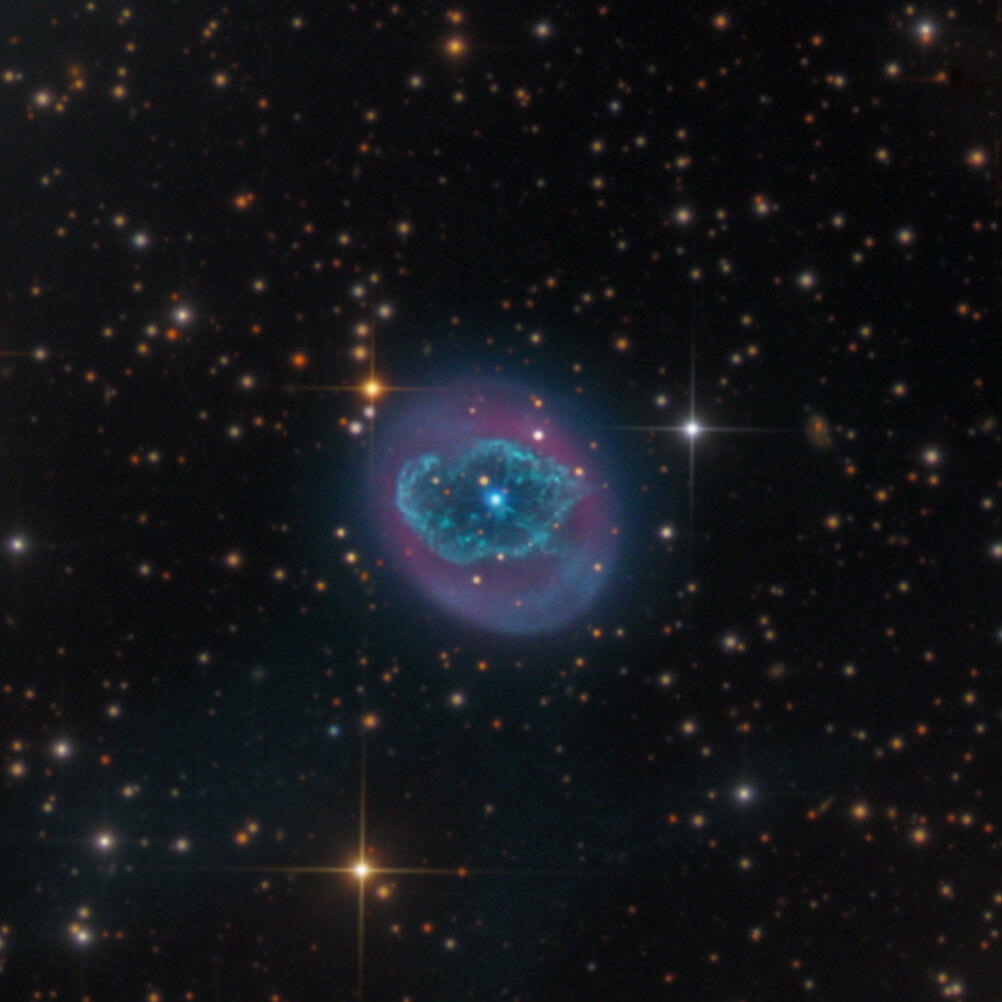
Abell-78
Abell 78
This planetary nebula has the unusual property of having a faint outer halo composed of normal stellar material (mostly hydrogen) and a bright inner elliptical ring composed mostly of helium. The helium ring provides direct confirmation that hydrogen is being converted to helium in the centers of stars and can later be ejected back into the galaxy's pool of gas for building another generation of enriched stars.
Shape: bright central zones and faint extended outer halo
Location: Cygnus constellation

NGC 1501
NGC 1501 is a complex planetary nebula located in the constellation of Camelopardalis
Discovered by William Herschel in 1787, NGC 1501 is a planetary nebula that is just under 5,000 light-years away from us. Astronomers have modeled the three-dimensional structure of the nebula, finding it to be a cloud shaped as an irregular ellipsoid filled with bumpy and bubbly regions. It has a bright central star that can be seen easily in this image, shining brightly from within the nebula’s cloud. This bright pearl embedded within its glowing shell inspired the nebula’s popular nickname: the Oyster Nebula.
While NGC 1501's central star blasted off its outer shell long ago, it still remains very hot and luminous, although it is quite tricky for observers to spot through modest telescopes. This star has actually been the subject of many studies by astronomers due to one very unusual feature: it seems to be pulsating, varying quite significantly in brightness over a typical timescale of just half an hour. While variable stars are not unusual, it is uncommon to find one at the heart of a planetary nebula.
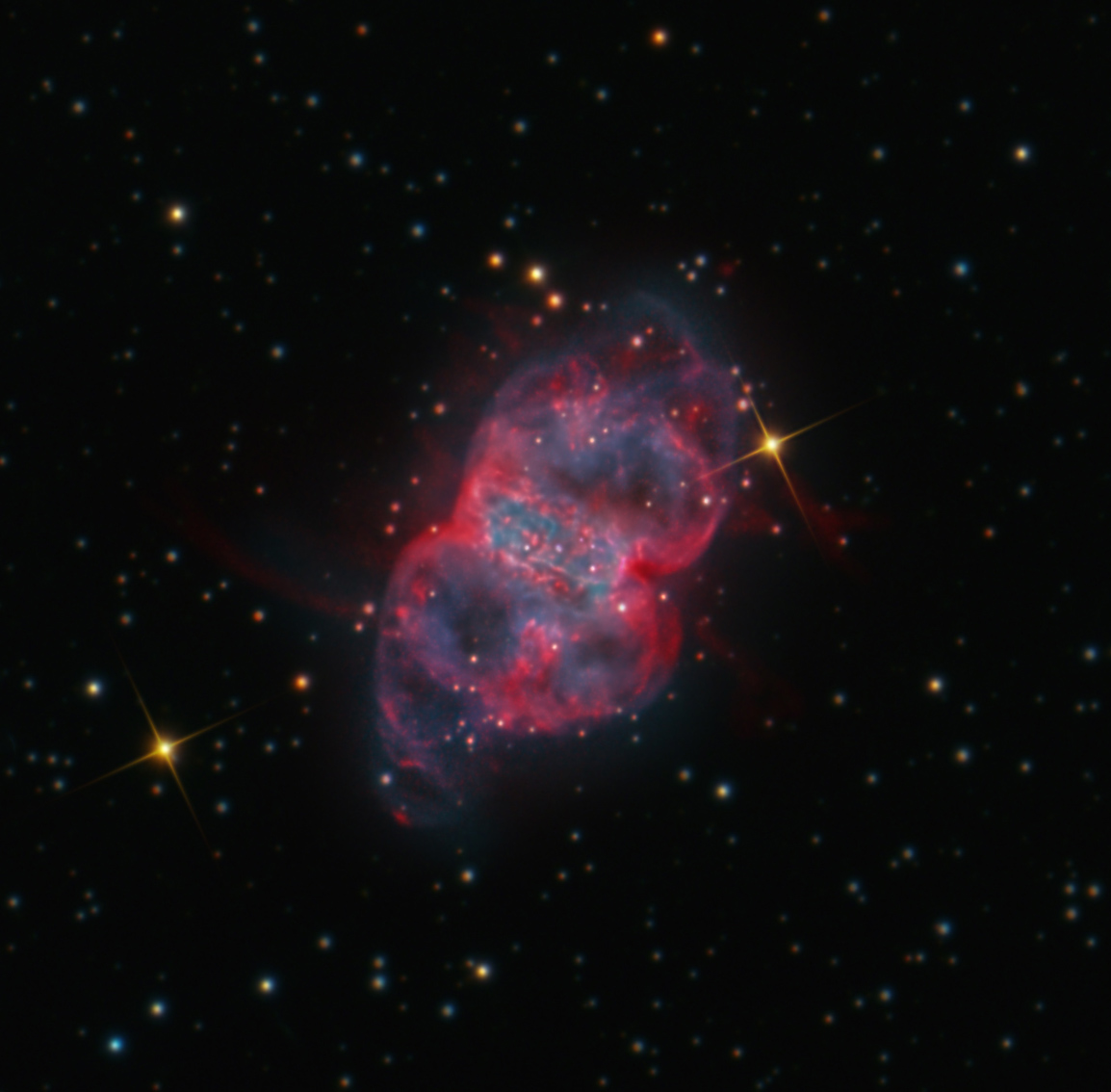
M76
Explanation: "Nebula at the right foot of Andromeda ... " begins the description for the 76th object in Charles Messier's 18th century Catalog of Nebulae and Star Clusters. In fact, M76 is one of the fainter objects on the Messier list and is also known by the popular name of the "Little Dumbbell Nebula". Like its brighter namesake M27 (the Dumbbell Nebula), M76 is recognized as a planetary nebula - a gaseous shroud cast off by a dying sunlike star. The nebula itself is thought to be shaped more like a donut, while the box-like appearance of its brighter central region is due to our nearly edge-on view. Gas expanding more rapidly away from the donut hole produces the fainter loops of far flung material. The fainter material is emphasized in this composite image, highlighted by showing emission from hydrogen atoms in orange and oxygen atoms in complementary blue hues. The nebula's dying star can be picked out in the sharp false-color image as the blue-tinted star near the center of the box-like shape. Distance estimates place M76 about 3 to 5 thousand light-years away, making the nebula over a light-year in diameter.
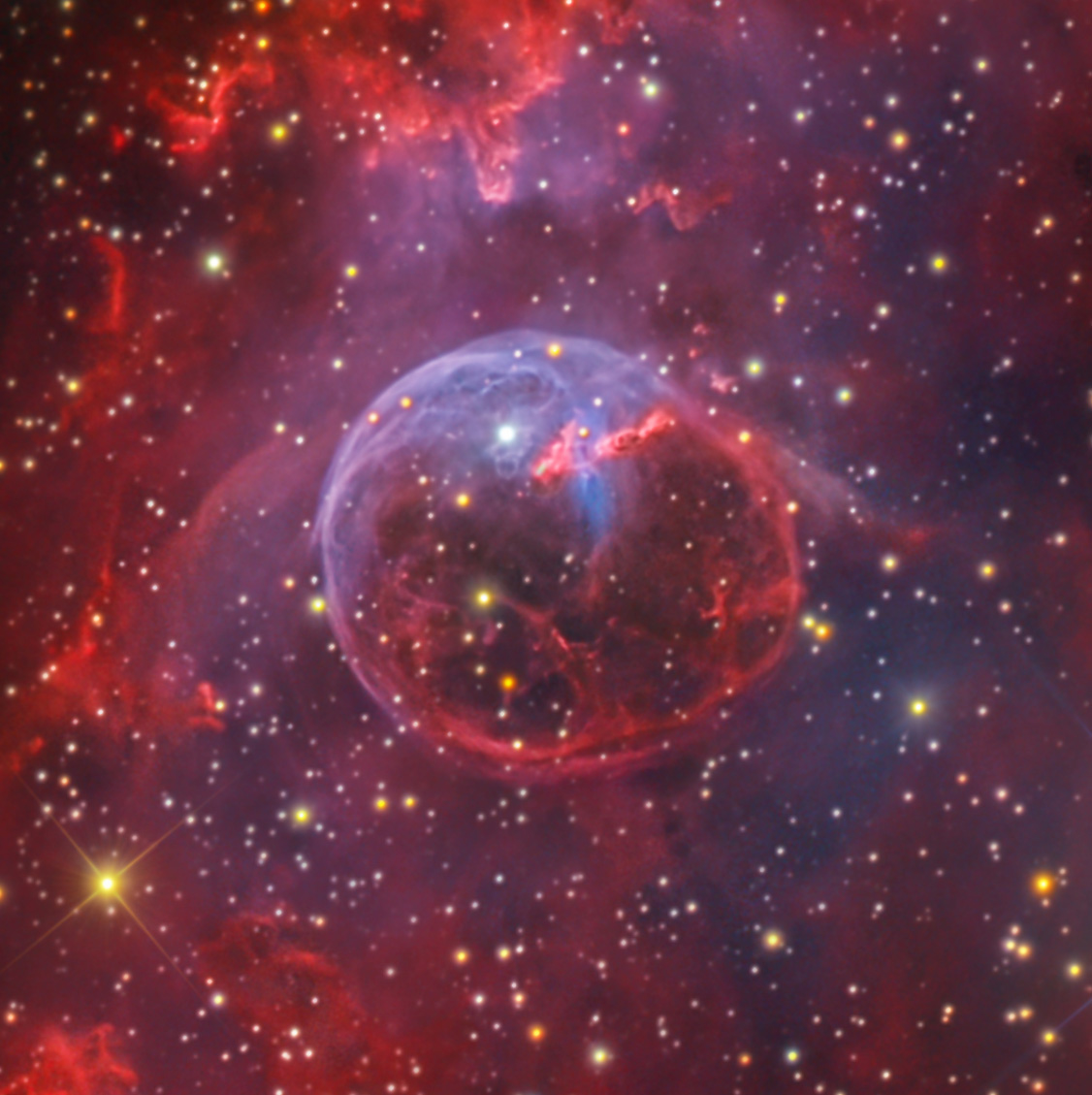
Bubble Nebula - NGC 7635 From GBO
NGC 7635, also known as the Bubble Nebula, Sharpless 162, or Caldwell 11, is a H II region[1] emission nebula in the constellation Cassiopeia. It lies close to the direction of the open cluster Messier 52. The "bubble" is created by the stellar wind from a massive hot, 8.7[1] magnitude young central star, SAO 20575 (BD+60°2522).[7] The nebula is near a giant molecular cloud which contains the expansion of the bubble nebula while itself being excited by the hot central star, causing it to glow.[7] It was discovered in 1787 by William Herschel.[5] The star BD+60°2522 is thought to have a mass of about 44 M☉.
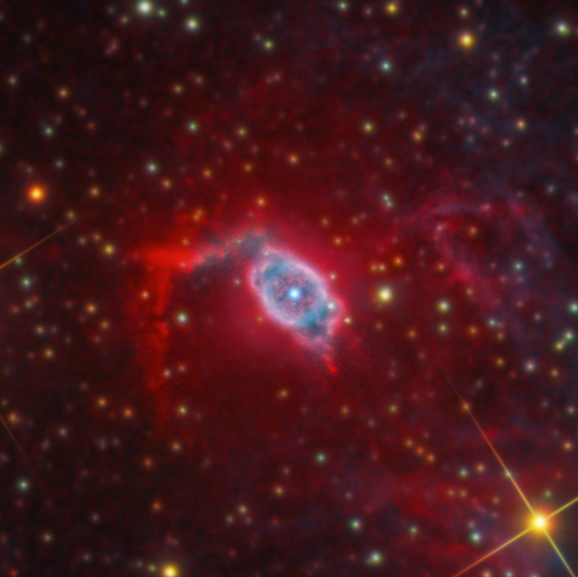
NGC 40-CTA1
"NGC 40 is a bright planetary nebula consisting of a detailed core with an outer halo. This halo consists of a double structure with a diffuse inner halo attached to the central shell and a more irregular filamentary structure, which extends to the north. In addition to these array of features is a structure to the south, which has been interpreted as a jet. Professional observations with the Spitzer infrared telescope have shown the inner halo to consist of multiple overlapping radial spoke ring structures. This halo was discovered in 1987.
The central star of this planetary nebula has been well studied by professional astronomers and is also interesting in its own right. It belongs to the Wolf Rayet subclass of planetary nebula central stars that are hydrogen deficient and exhibit high mass loss rates and strong stellar winds. WR type central stars have been identified in a number of other planetary nebulae including IC 4663 and Abell 48.
Extending along the contours of the full field of this image are multiple colourful filaments belonging to the large faint supernova remnant CTA 1, which covers an area of 1.5 degrees across the sky. Both NGC 40 and CTA 1 are physically unrelated with the supernova remnant lying more distant in the background. NGC 40 is 3500 light years away and CTA 1 is 4500 light years away."
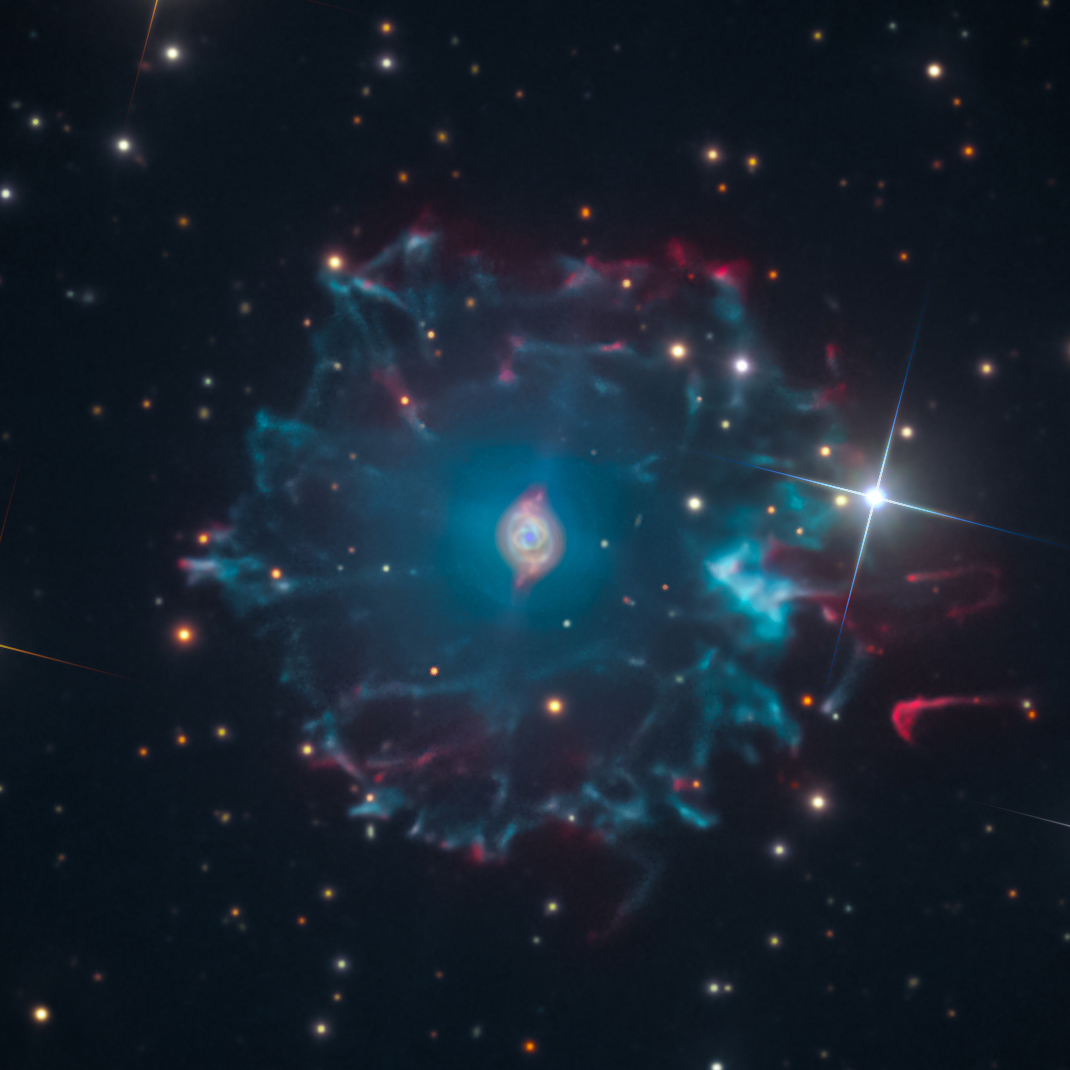
Cats Eye Nebula (SWO)
Explanation: The Cat's Eye Nebula (NGC 6543) is one of the best known planetary nebulae in the sky. Its more familiar outlines are seen in the brighter central region of the nebula in this impressive wide-angle view. But the composite image combines many short and long exposures to also reveal an extremely faint outer halo. At an estimated distance of 3,000 light-years, the faint outer halo is over 5 light-years across. Planetary nebulae have long been appreciated as a final phase in the life of a sun-like star. More recently, some planetary nebulae are found to have halos like this one, likely formed of material shrugged off during earlier episodes in the star's evolution. While the planetary nebula phase is thought to last for around 10,000 years, astronomers estimate the age of the outer filamentary portions of this halo to be 50,000 to 90,000 years. Visible on the left, some 50 million light-years beyond the watchful planetary nebula, lies spiral galaxy NGC 6552.
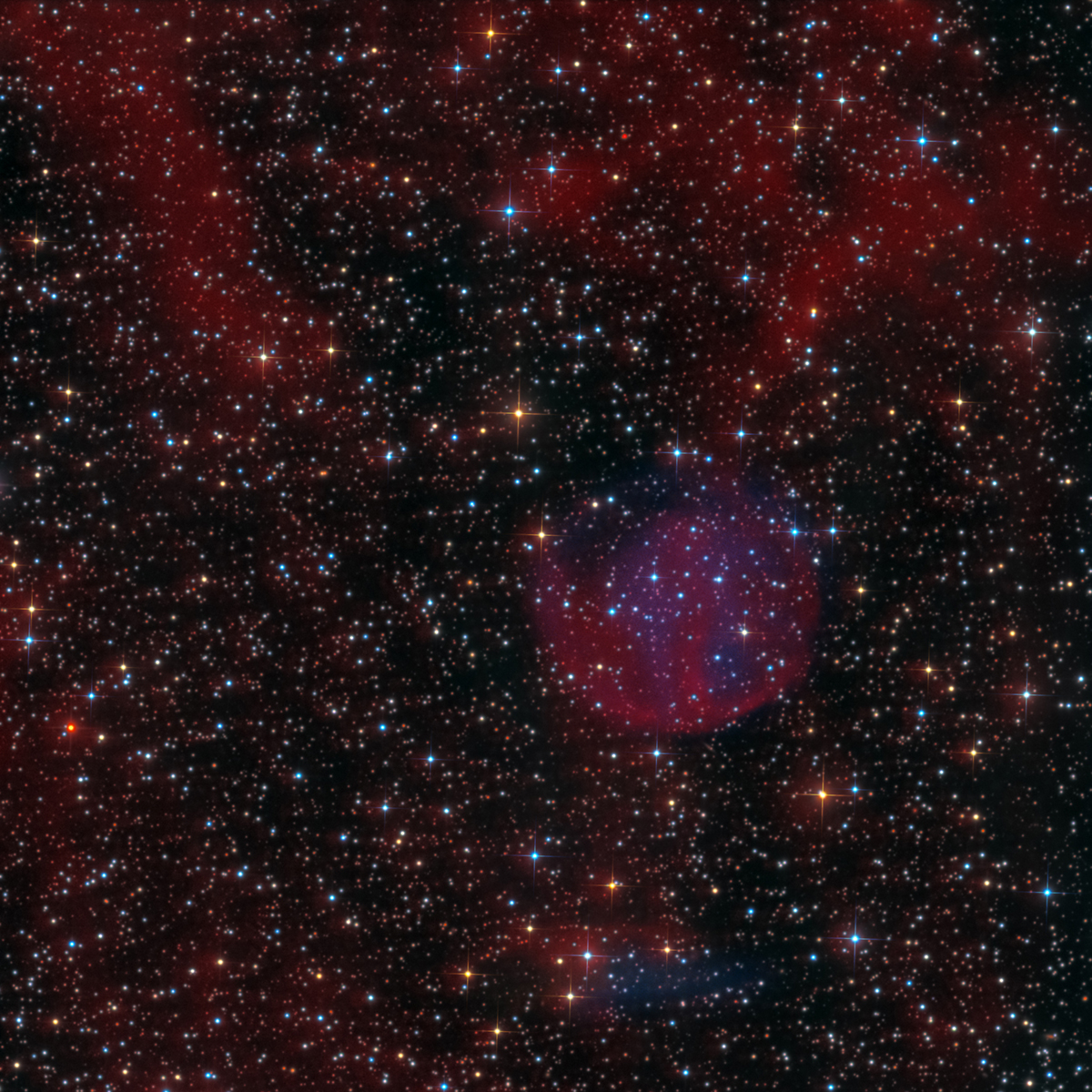
CaVa 1 Planetary Nebula (SWO)
"CaVa 1 is an obscure ancient planetary nebula that was discovered by the French amateur astronomers Jean-Paul Cales and Michael Vanhuysse in 2017. It has a size of 8x7 arcminutes and is located in a region of background nebulosity. There is sometimes a relation between the size of a planetary nebula, its age and its relative faintness. Older planetary nebulae over time eventually expand more and the ionizing energy is spread over a larger area as well as the density of the gas being thinner, so therefore exhibit lower surface brightness. This is easily overcome by amateur astronomers who are able to obtain very long exposures. Large low surface brightness planetary nebulae have been discovered in professional Ha surveys and also by amateurs analysing various astronomical survey data.
CaVa 1 consists of primarily Ha emission with some OIII in its interior. The southern part exhibits a tenuous bowshock structure produced by its interaction with the surrounding interstellar medium (ISM). Few examples of planetary nebulae with ISM interaction are known due to their extremely low intrinsic brightness. This stage in the evolution of a planetary nebula precedes the total dilution and fading of a planetary nebula. However, the phenomenon of ISM interaction has been observed in young planetary nebulae with high speed central stars and studies conclude that different stages of interaction are exhibited throughout the life of planetary nebulae. The idea of a planetary nebula interacting with the ISM as it moves through space was proposed in 1969 by the Armenian astronomer Grigor Gurzadyan."
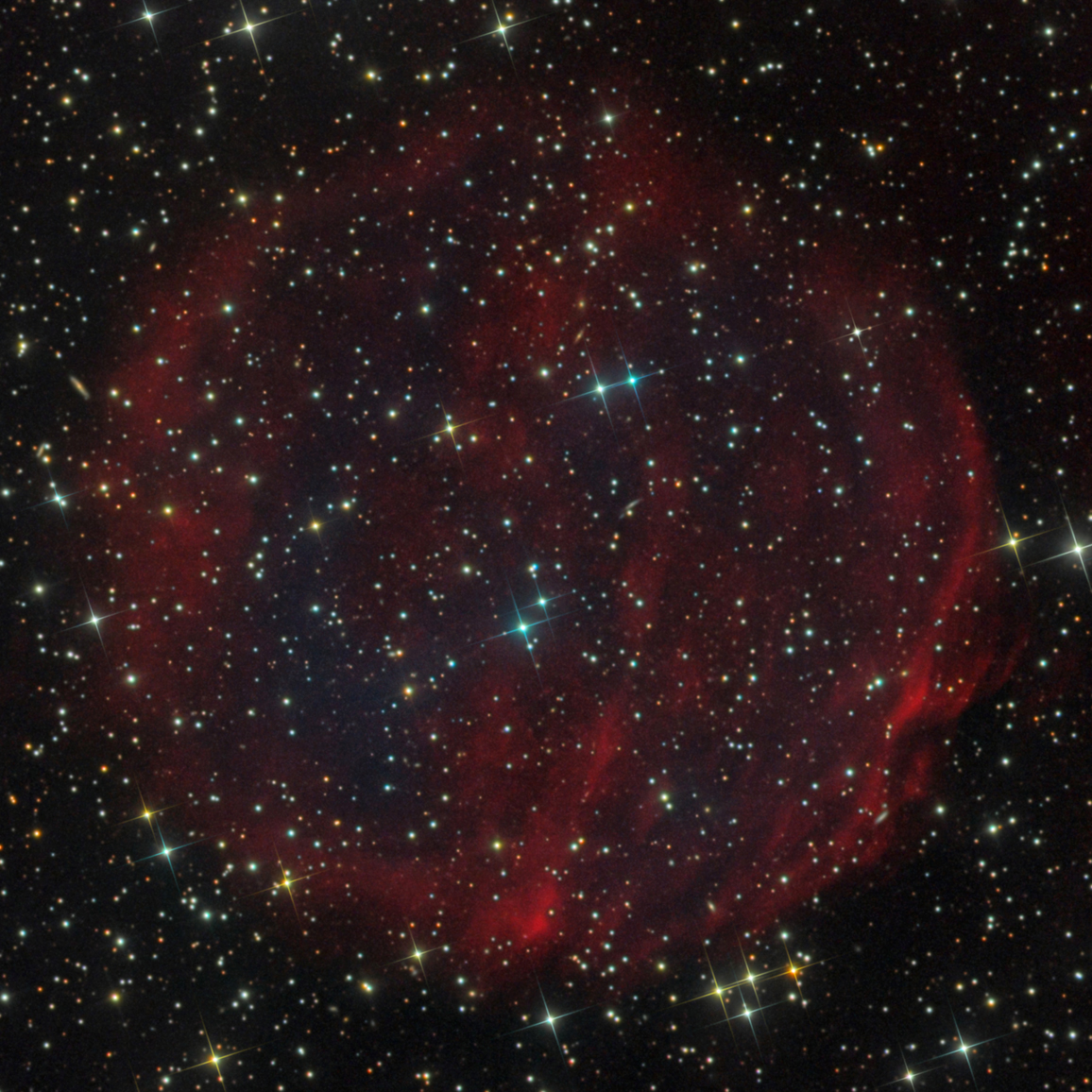
PuWe1 (PNG 158.9 + 17.8), in Lynx (SWO)
PuWe1 (PNG 158.9 + 17.8), in Lynx, is one of the largest PN, that has an apparent diameter of 20'. It has been discovered by Purgathofer & Weinberger in 1980 on a Palomar sky survey print.
As almost all this kind of old diluted PN, it is very faint and requires long exposures to get details. The Halpha signal is the strongest and draws a ring with several details in the structure while the OIII signal is extremely faint with a disc shape and no visible structure.
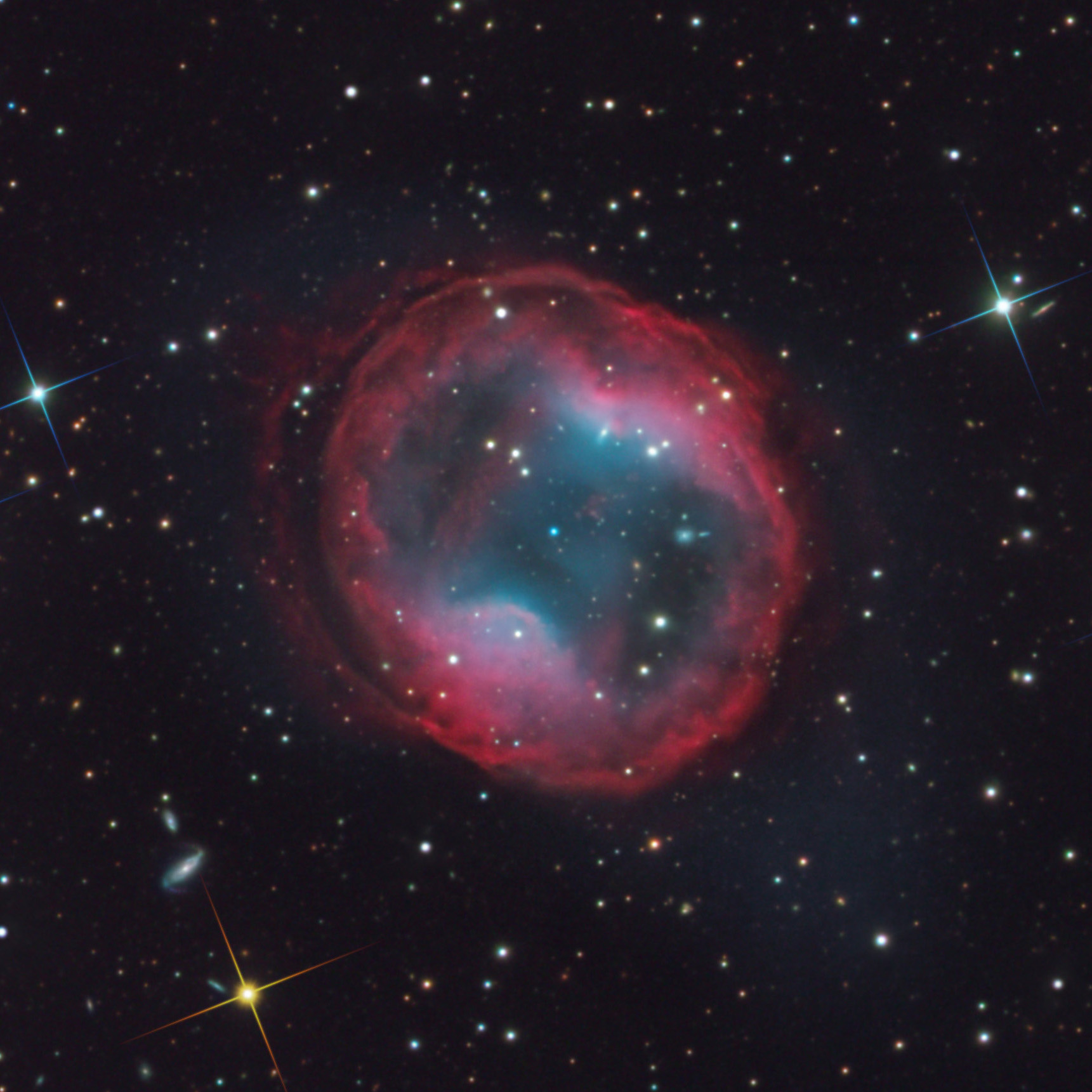
PK 164+31.1 Jones-Emberson 1 (SWO)
PK 164+31.1 Jones-Emberson 1
Explanation APOD: Is this what will become of our Sun? Quite possibly. The bubble of expanding gas pictured above is the planetary nebula PK 164 +31.1, the remnants of the atmosphere of a Sun-like star expelled as its supply of fusion-able core hydrogen became depleted. Visible near the center of the nebula is what remains of the core itself -- a blue-hot white dwarf star. This particularly photogenic planetary nebula shows intricate shells of gas likely expelled at different times toward the end the star's demise, and whose structure is not fully understood. This deep image of PK 164 +31.1 shows many other stars from our own Milky Way Galaxy as well as several galaxies far in the distance. PK 164 +31, also known as Jones-Emberson 1, lies about 1,600 light years away toward the constellation of the Wildcat (Lynx). Due to its faintness (magnitude 17) and low surface brightness, the object is only visible with a good-sized telescope. Although the expanding nebula will fade away over the next few thousand years, the central white dwarf may well survive for billions of years -- to when our universe may be a very different place.
Exposure Details:
Telescope: Planewave 24" f6.7 on a Planewave HD Mount Camera: SBIG 16803
Location: Stellar Winds Observatory at DSNM, Animas, New Mexico
Exposure: L,R,G,B,HA,03 500,210,210,210,1350,1440 65Hours of exposure so far. Still working on the O3 data.
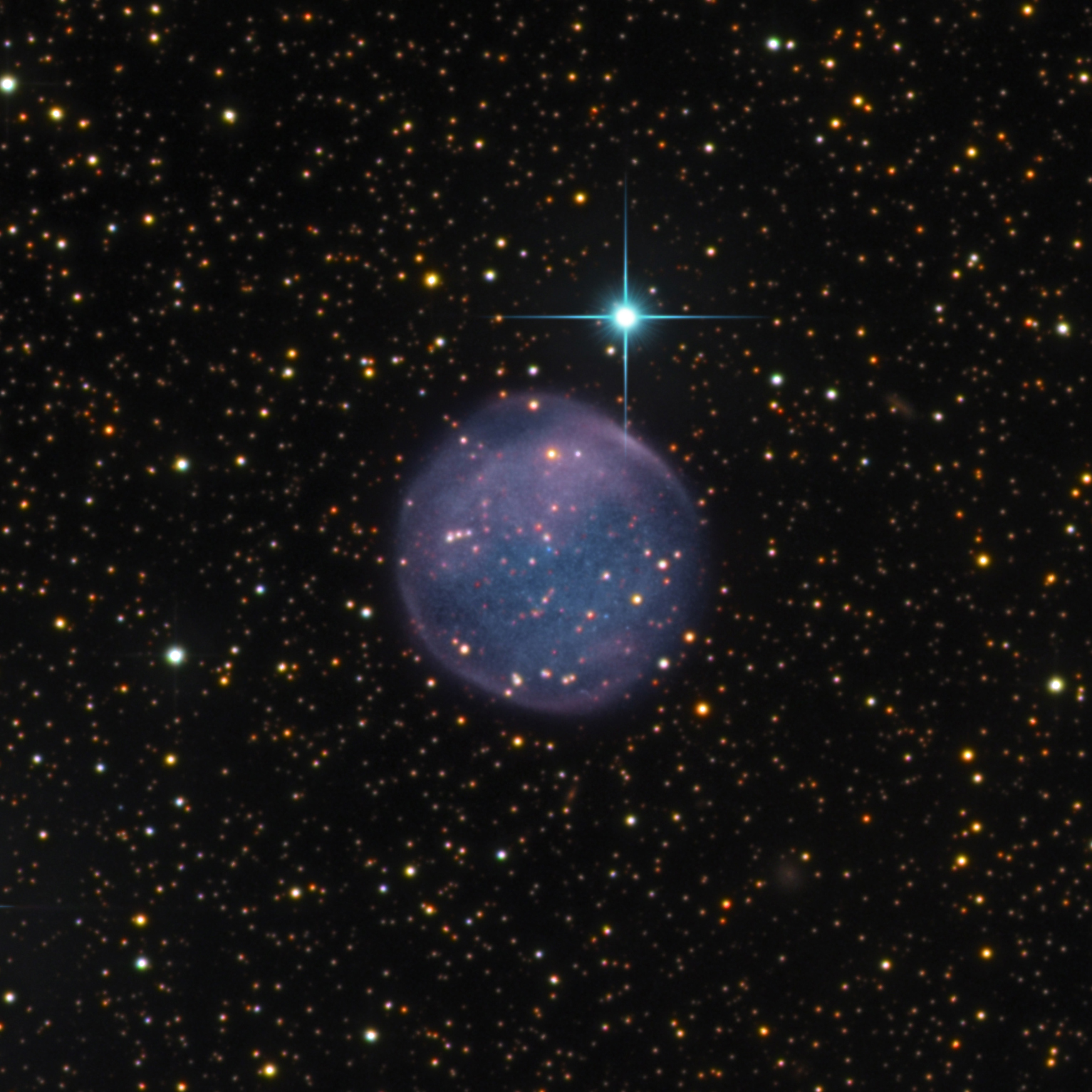
IPHASX J015624.9+652830
IPHASX J015624.9+652830 is a planetary nebula that was discovered as part of the IPHAS survey. It was spectroscopically confirmed as a true planetary nebula by the professional astronomer Laurence Sabin in September 2011. It has also been independently discovered by the French amateur astronomer Laurent Ferrero in 2013 and is also known as Fe 6. Its structure consists of a low surface brightness bubble with a size of 3.5 arcminutes, which is accentuated by a thin "bright" rim on the outside. It is very likely to be an ancient evolved planetary nebula that is interacting with the interstellar medium (ISM) and its intensely blue central star is easily visible near the centre. Despite its faintness, it is possible to visually observe it in very large telescopes.
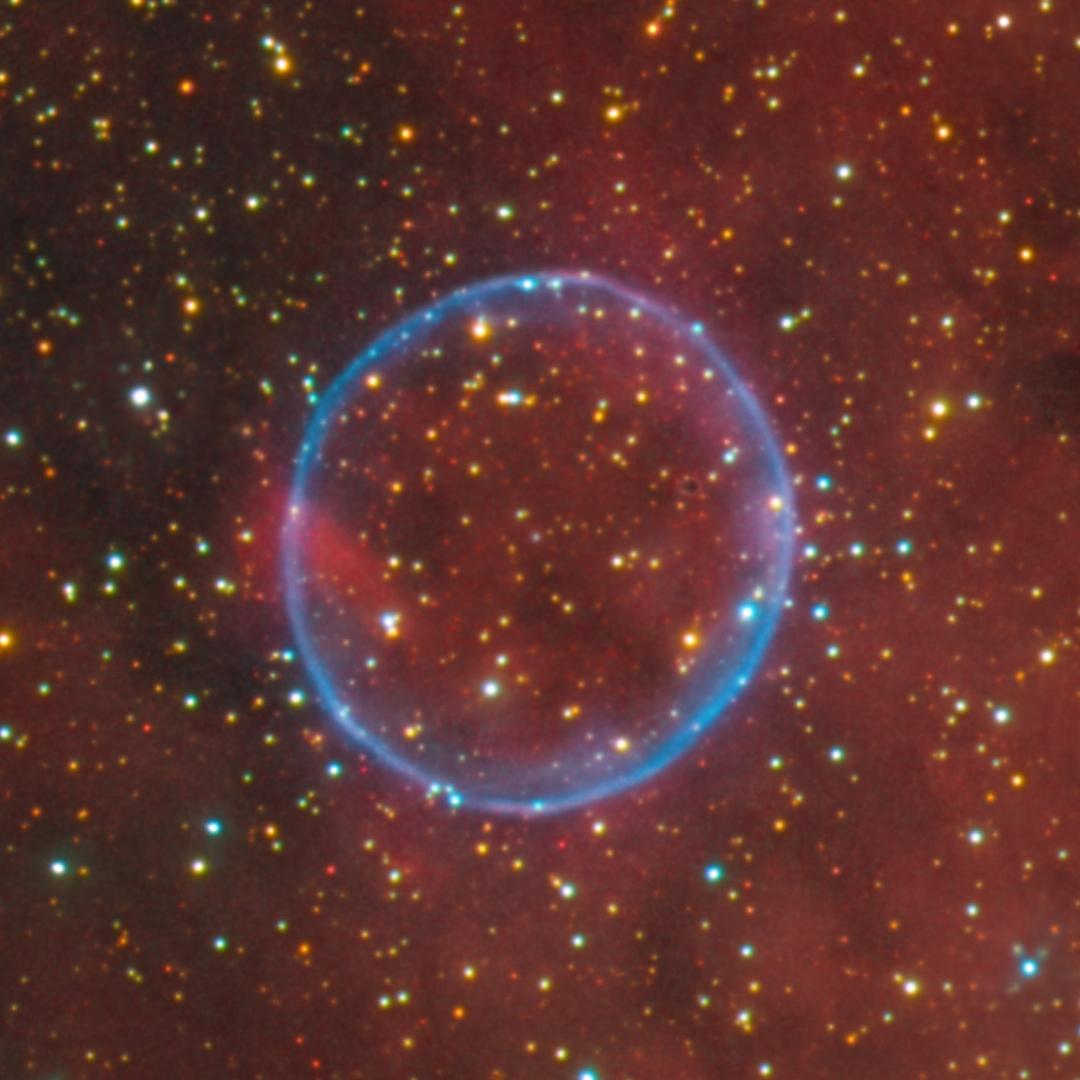
The Soap Bubble Nebula PN G75.5+1.7 (SWO)
The Soap Bubble Nebula PN G75.5+1.7
Explanation From APOD:
Adrift in the rich star fields of the constellation Cygnus, this lovely, symmetric nebula was only recognized a few years ago and does not yet appear in some astronomical catalogs. In fact, amateur astronomer Dave Jurasevich identified it as a nebula on 2008 July 6 in his images of the complex Cygnus region that included the Crescent Nebula (NGC 6888). He subsequently notified the International Astronomical Union. Only eleven days later the same object was independently identified by Mel Helm at Sierra Remote Observatories, imaged by Keith Quattrocchi and Helm, and also submitted to the IAU as a potentially unknown nebula. The nebula s now known as the Soap Bubble Nebula. Most probably it is a planetary nebula, a final phase in the life of a sun-like star.
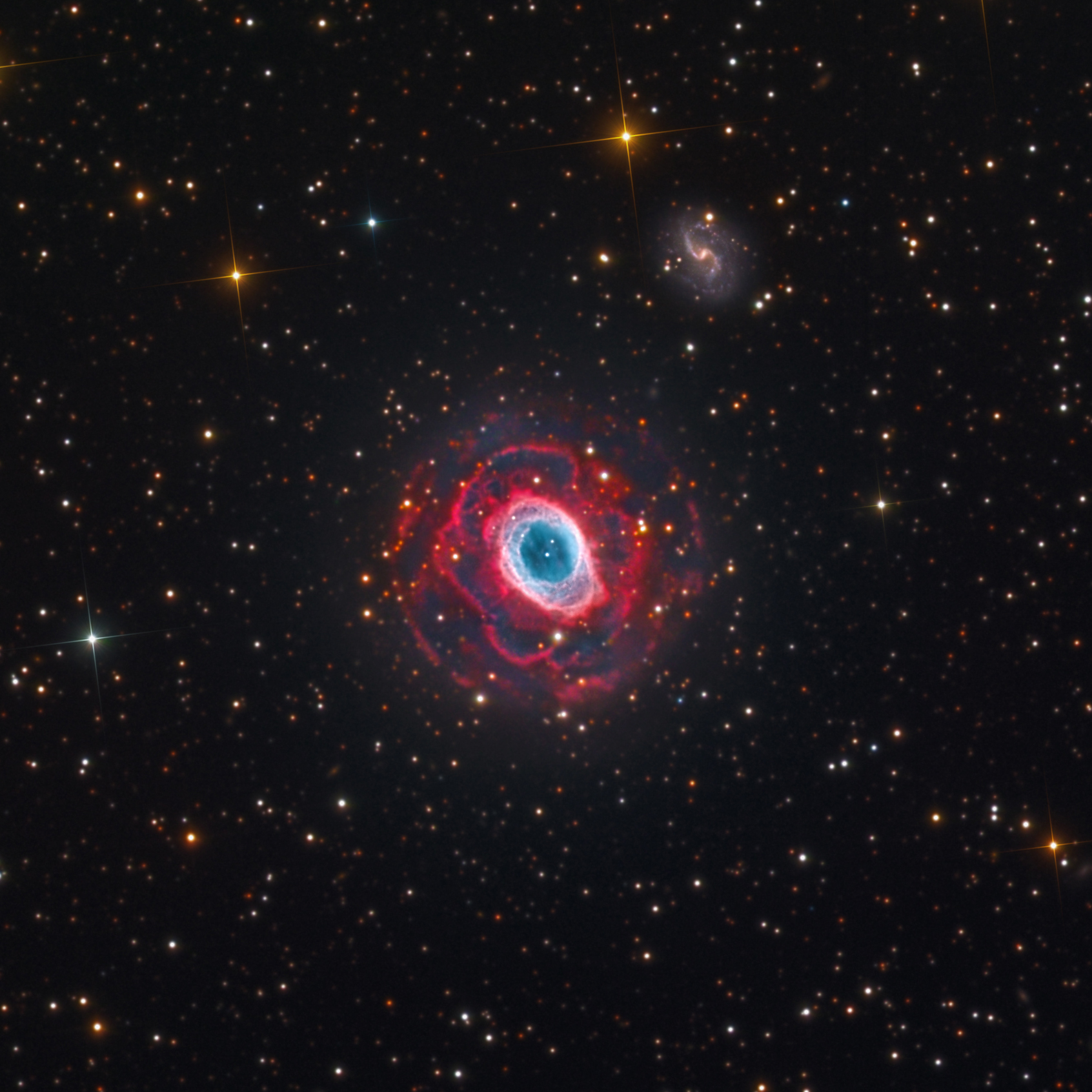
M57 The Ring Nebula (SWO)
The Ring Nebula (also catalogued as Messier 57, M57 or NGC 6720) is a planetary nebula in the northern constellation of Lyra. Such objects are formed when a shell of ionized gas is expelled into the surrounding interstellar medium by a red giant star, which was passing through the last stage in its evolution before becoming a white dwarf.


























